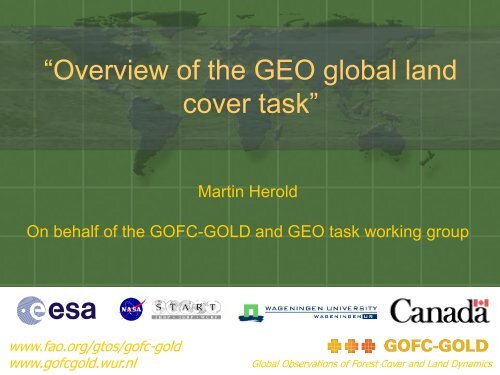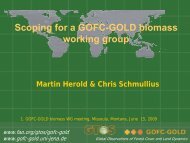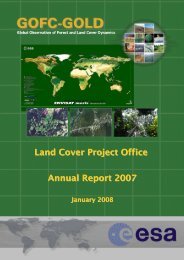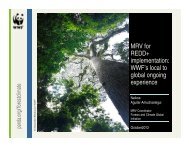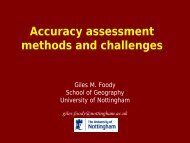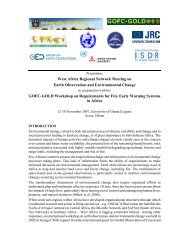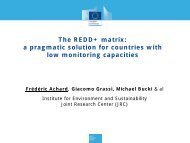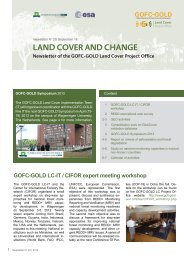Structure of the SB-02 Global Land Cover
Structure of the SB-02 Global Land Cover
Structure of the SB-02 Global Land Cover
Create successful ePaper yourself
Turn your PDF publications into a flip-book with our unique Google optimized e-Paper software.
“Overview <strong>of</strong> <strong>the</strong> GEO global land<br />
cover task”<br />
Martin Herold<br />
On behalf <strong>of</strong> <strong>the</strong> GOFC-GOLD and GEO task working group<br />
www.fao.org/gtos/g<strong>of</strong>c-gold<br />
www.g<strong>of</strong>cgold.wur.nl<br />
<strong>Global</strong> Observations <strong>of</strong> Forest <strong>Cover</strong> and <strong>Land</strong> Dynamics
GEO societal benefits and land cover observations<br />
Water<br />
Water resources / quality<br />
<strong>Land</strong>+water use pattern<br />
Climate<br />
<strong>Land</strong> change &GHG emis.<br />
Water+energy exchanges<br />
Wea<strong>the</strong>r<br />
<strong>Land</strong>–surface climate int.<br />
Vegetation characteristics<br />
Energy<br />
Bio-energy/biomass<br />
Wind/hydro power assess.<br />
Ecosystems<br />
Change environment cond.<br />
Services + accounting<br />
Health<br />
<strong>Land</strong> change / disease<br />
vectors / boundary cond.<br />
Disasters<br />
Fire monitoring<br />
<strong>Land</strong> degradation assess.<br />
Biodiversity<br />
Ecosystem characteristics<br />
Habitats + fragmentation<br />
Agriculture<br />
Cultivation pattern+forestry<br />
<strong>Land</strong> degradations
ESA – GLOBCOVER global land cover map 2009
ESA – GLOBCOVER global land cover map 2009<br />
GLOBCOVER users – institutions Proportion (%)<br />
Commercial Sectors 20.97<br />
Governmental organizations 13.98<br />
Non-governmental organizations 17.20<br />
University / research institutions 47.85<br />
Total 100.00<br />
Source: ESA/WU Globcover user survey 2010 (N = 372)
Key challenges for earth observation community<br />
1. <strong>Land</strong> cover observations are not operational<br />
2. Engagement in political discussions and participation<br />
in policy development and implementation:<br />
‣ Specify requirements, priorities and consensus technical input<br />
3. Technically straightforward to produce land cover<br />
maps using a combination <strong>of</strong> satellite & in-situ data:<br />
‣ Focus on saliency and legitimacy as well as technical credibility<br />
‣ Address <strong>the</strong> needs <strong>of</strong> multiple user communities<br />
4. Overcome existing heterogeneity:<br />
‣ Integrated observations driven by agreed international standards<br />
‣ Robust and comparative accuracy assessments<br />
5. Advance scientific foundations:<br />
‣ <strong>Land</strong> change monitoring strategies and techniques<br />
‣ Best practices and recommendations
<strong>SB</strong>-<strong>02</strong><br />
<strong>Structure</strong> <strong>of</strong> <strong>the</strong> <strong>SB</strong>-<strong>02</strong> <strong>Global</strong> <strong>Land</strong> <strong>Cover</strong><br />
C1 <strong>Global</strong> <strong>Land</strong> <strong>Cover</strong><br />
Datasets and Service<br />
China (Pr<strong>of</strong>. Chen Jun (PoC))<br />
USGS (Dr. Chandra Giri)<br />
Canada (Pr<strong>of</strong>. Songnian Li,<br />
Ryerson University)<br />
Spain (Dr. Antonio Arozarena,<br />
IGN-CNIG)<br />
ESA (Dr. Olivier Arino)<br />
C2 <strong>Global</strong> <strong>Land</strong> <strong>Cover</strong><br />
Validation and User<br />
Engagement<br />
EEA (Dr. Chris Steenmans)<br />
(PoC)<br />
NSDI, China (Dr.Lijun Chen)<br />
GOFC-GOLD/University <strong>of</strong><br />
Wageningen (Dr. Brice Mora)<br />
C3 <strong>Global</strong> <strong>Land</strong> <strong>Cover</strong><br />
Methodology and Capacity<br />
Building/Outreach<br />
GOFC-GOLD (Pr<strong>of</strong>. Martin Herold<br />
(PoC))<br />
Tsinghua University, China (Pr<strong>of</strong>.<br />
Peng Gong )<br />
KTH, Sweden (Pr<strong>of</strong>. Yifang Ban)<br />
EARSeL (Dr. Ioannis Manakos)<br />
KEIO University, Japan (Pr<strong>of</strong>.<br />
Wanglin Yan)<br />
Central South University, China<br />
(Pr<strong>of</strong>. Yongnian Zeng)
Some objectives for today<br />
1. Present progress and activities:<br />
– <strong>Global</strong> land cover datasets<br />
– Validation and user engagement<br />
2. Have discussions on next key activities to<br />
evolve <strong>the</strong> task:<br />
– Beyond <strong>the</strong> activities <strong>of</strong> individual contributors<br />
– Where GEO can help and add value<br />
– Ensure good engagement with GOFC-GOLD<br />
community
Some objectives and needs for discussions<br />
1. Most advances <strong>of</strong> <strong>the</strong> task are individual progress<br />
reports - what are key areas to evolve on <strong>the</strong><br />
group level and where GEO can add value<br />
2. Many users/<strong>SB</strong>As/GEO tasks need land cover<br />
data – how to understand and meet <strong>the</strong>ir needs<br />
3. Most activities are global with little interactions<br />
with GEO members – how to better engage with<br />
regional and national-level initiatives<br />
4. What's your contribution and expectation from<br />
GEO (o<strong>the</strong>r tasks and GEO Members) 2013, and<br />
what for 2015<br />
5. How to engage in more capacity building


